Auditing and Assurance Report: ABC Learning Centre Analysis
VerifiedAdded on 2020/03/16
|16
|3544
|58
Report
AI Summary
This report provides an executive summary of auditing and assurance, focusing on how various auditing standards protect against market frauds. It emphasizes the role of auditing in identifying threats and evaluating risks, particularly for ABC Learning Centre. The report targets ASA 701 and ASA 570, highlighting their importance in assessing internal controls and ensuring business performance. It includes an introduction, background analysis of financial statements (income statement, balance sheet, and cash flow statements), and a detailed analysis of the financial data provided for ABC Learning Centre. The report also discusses the application of the going concern principle and the implications of non-compliance. The report concludes with recommendations for improving performance and achieving organizational goals. The financial statements analysis includes a cash flow projection and income statement and balance sheet comparison for the years 2011 and 2012.
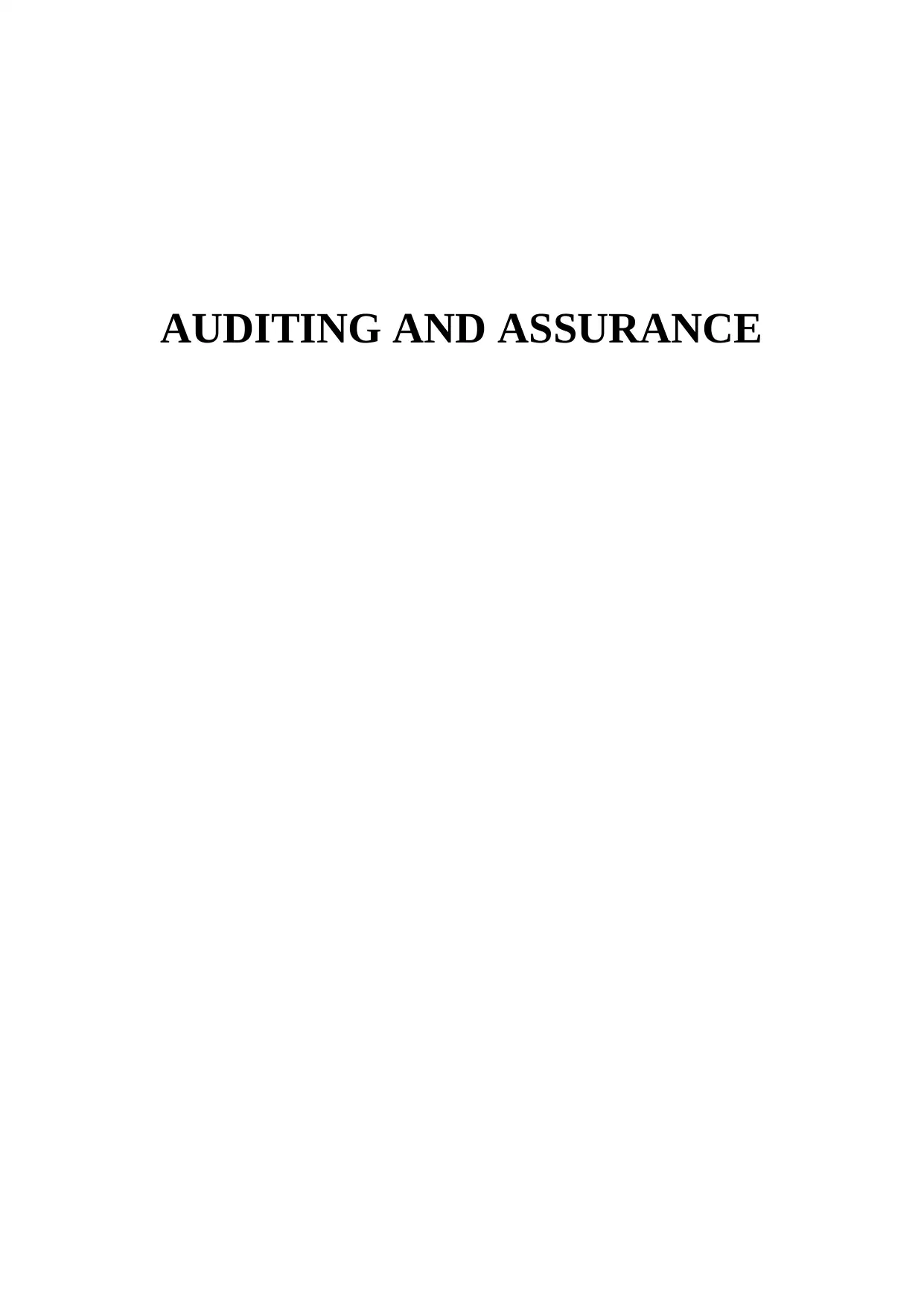
AUDITING AND ASSURANCE
Paraphrase This Document
Need a fresh take? Get an instant paraphrase of this document with our AI Paraphraser
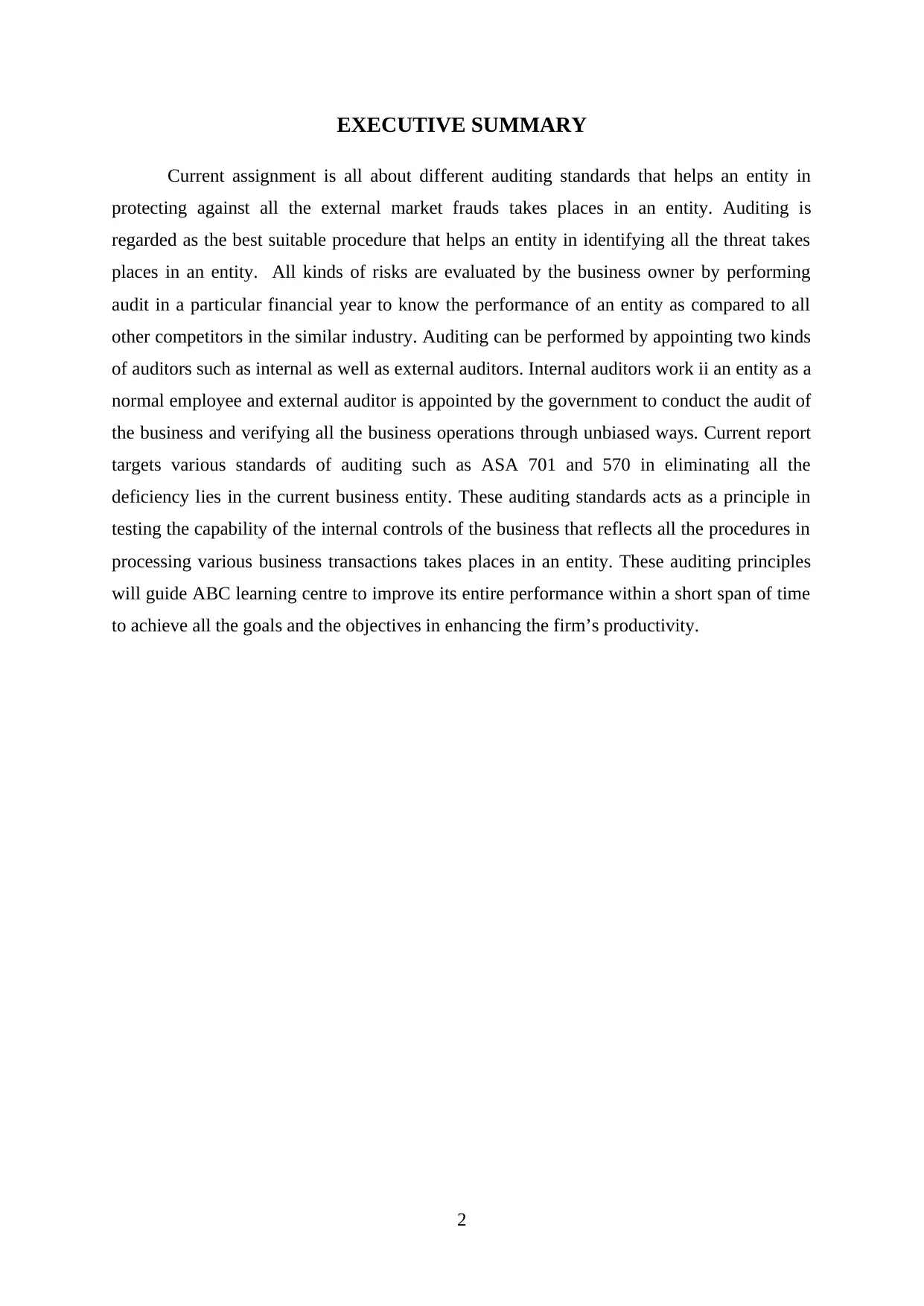
EXECUTIVE SUMMARY
Current assignment is all about different auditing standards that helps an entity in
protecting against all the external market frauds takes places in an entity. Auditing is
regarded as the best suitable procedure that helps an entity in identifying all the threat takes
places in an entity. All kinds of risks are evaluated by the business owner by performing
audit in a particular financial year to know the performance of an entity as compared to all
other competitors in the similar industry. Auditing can be performed by appointing two kinds
of auditors such as internal as well as external auditors. Internal auditors work ii an entity as a
normal employee and external auditor is appointed by the government to conduct the audit of
the business and verifying all the business operations through unbiased ways. Current report
targets various standards of auditing such as ASA 701 and 570 in eliminating all the
deficiency lies in the current business entity. These auditing standards acts as a principle in
testing the capability of the internal controls of the business that reflects all the procedures in
processing various business transactions takes places in an entity. These auditing principles
will guide ABC learning centre to improve its entire performance within a short span of time
to achieve all the goals and the objectives in enhancing the firm’s productivity.
2
Current assignment is all about different auditing standards that helps an entity in
protecting against all the external market frauds takes places in an entity. Auditing is
regarded as the best suitable procedure that helps an entity in identifying all the threat takes
places in an entity. All kinds of risks are evaluated by the business owner by performing
audit in a particular financial year to know the performance of an entity as compared to all
other competitors in the similar industry. Auditing can be performed by appointing two kinds
of auditors such as internal as well as external auditors. Internal auditors work ii an entity as a
normal employee and external auditor is appointed by the government to conduct the audit of
the business and verifying all the business operations through unbiased ways. Current report
targets various standards of auditing such as ASA 701 and 570 in eliminating all the
deficiency lies in the current business entity. These auditing standards acts as a principle in
testing the capability of the internal controls of the business that reflects all the procedures in
processing various business transactions takes places in an entity. These auditing principles
will guide ABC learning centre to improve its entire performance within a short span of time
to achieve all the goals and the objectives in enhancing the firm’s productivity.
2
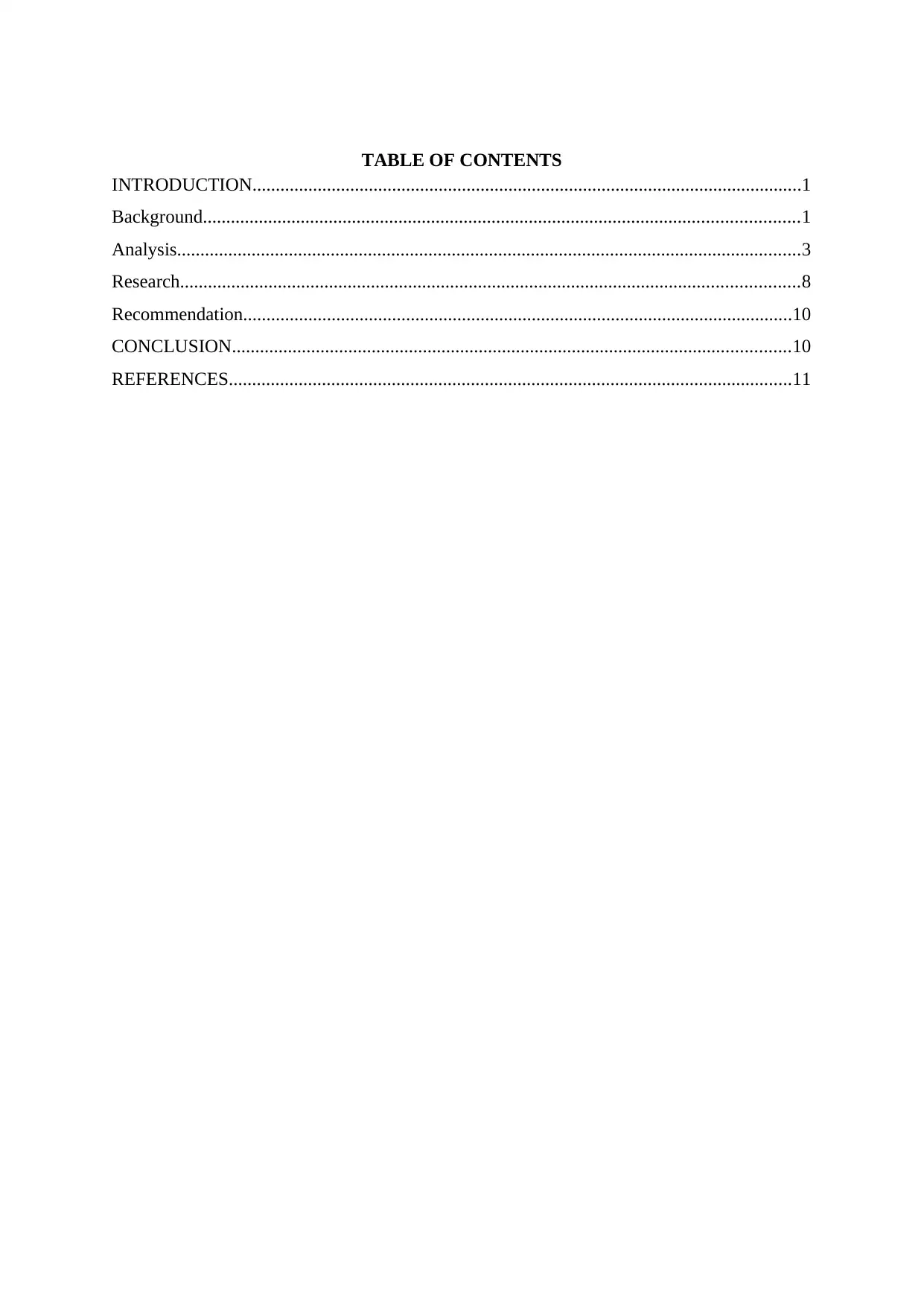
TABLE OF CONTENTS
INTRODUCTION......................................................................................................................1
Background................................................................................................................................1
Analysis......................................................................................................................................3
Research.....................................................................................................................................8
Recommendation......................................................................................................................10
CONCLUSION........................................................................................................................10
REFERENCES.........................................................................................................................11
INTRODUCTION......................................................................................................................1
Background................................................................................................................................1
Analysis......................................................................................................................................3
Research.....................................................................................................................................8
Recommendation......................................................................................................................10
CONCLUSION........................................................................................................................10
REFERENCES.........................................................................................................................11
⊘ This is a preview!⊘
Do you want full access?
Subscribe today to unlock all pages.

Trusted by 1+ million students worldwide
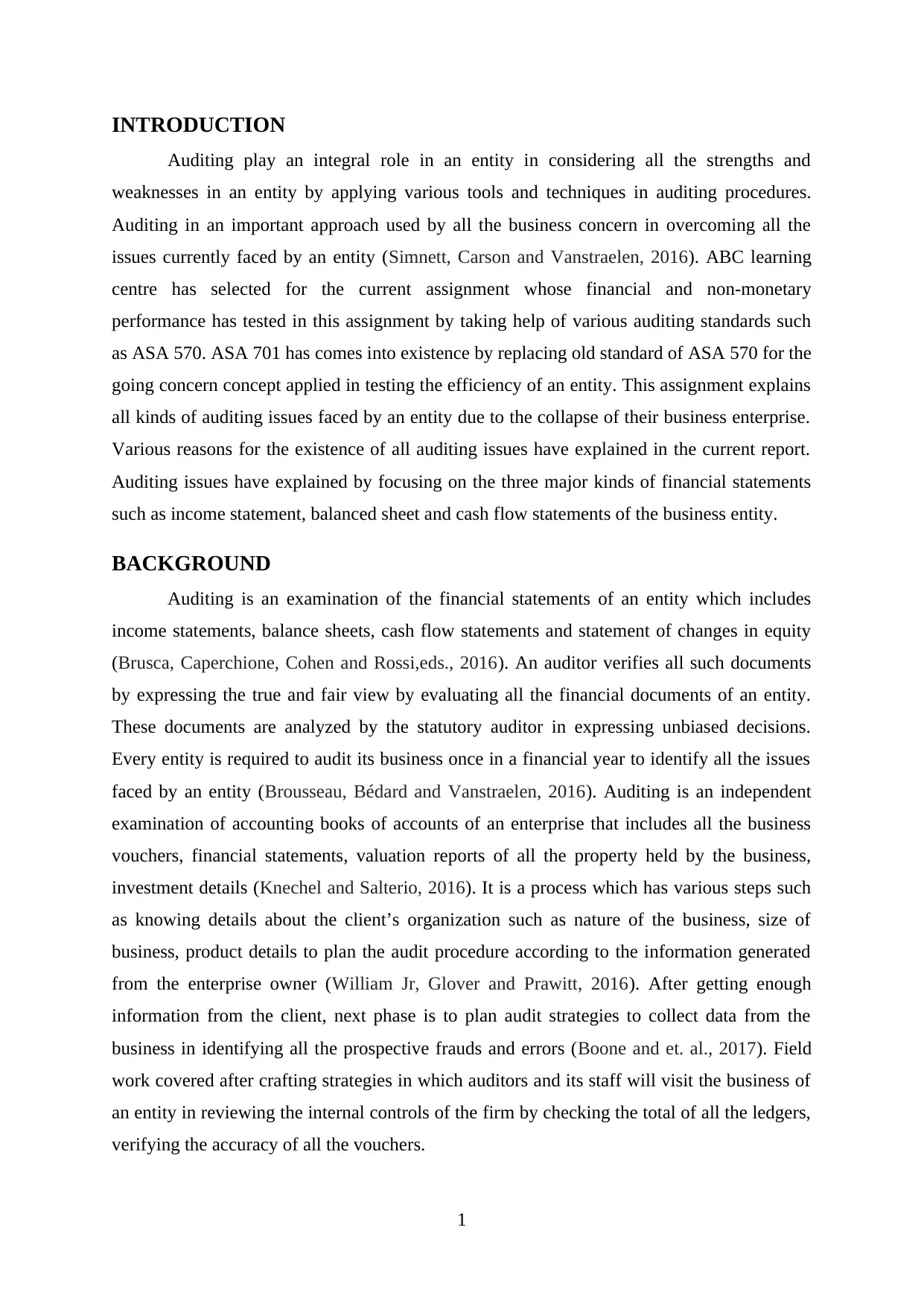
INTRODUCTION
Auditing play an integral role in an entity in considering all the strengths and
weaknesses in an entity by applying various tools and techniques in auditing procedures.
Auditing in an important approach used by all the business concern in overcoming all the
issues currently faced by an entity (Simnett, Carson and Vanstraelen, 2016). ABC learning
centre has selected for the current assignment whose financial and non-monetary
performance has tested in this assignment by taking help of various auditing standards such
as ASA 570. ASA 701 has comes into existence by replacing old standard of ASA 570 for the
going concern concept applied in testing the efficiency of an entity. This assignment explains
all kinds of auditing issues faced by an entity due to the collapse of their business enterprise.
Various reasons for the existence of all auditing issues have explained in the current report.
Auditing issues have explained by focusing on the three major kinds of financial statements
such as income statement, balanced sheet and cash flow statements of the business entity.
BACKGROUND
Auditing is an examination of the financial statements of an entity which includes
income statements, balance sheets, cash flow statements and statement of changes in equity
(Brusca, Caperchione, Cohen and Rossi,eds., 2016). An auditor verifies all such documents
by expressing the true and fair view by evaluating all the financial documents of an entity.
These documents are analyzed by the statutory auditor in expressing unbiased decisions.
Every entity is required to audit its business once in a financial year to identify all the issues
faced by an entity (Brousseau, Bédard and Vanstraelen, 2016). Auditing is an independent
examination of accounting books of accounts of an enterprise that includes all the business
vouchers, financial statements, valuation reports of all the property held by the business,
investment details (Knechel and Salterio, 2016). It is a process which has various steps such
as knowing details about the client’s organization such as nature of the business, size of
business, product details to plan the audit procedure according to the information generated
from the enterprise owner (William Jr, Glover and Prawitt, 2016). After getting enough
information from the client, next phase is to plan audit strategies to collect data from the
business in identifying all the prospective frauds and errors (Boone and et. al., 2017). Field
work covered after crafting strategies in which auditors and its staff will visit the business of
an entity in reviewing the internal controls of the firm by checking the total of all the ledgers,
verifying the accuracy of all the vouchers.
1
Auditing play an integral role in an entity in considering all the strengths and
weaknesses in an entity by applying various tools and techniques in auditing procedures.
Auditing in an important approach used by all the business concern in overcoming all the
issues currently faced by an entity (Simnett, Carson and Vanstraelen, 2016). ABC learning
centre has selected for the current assignment whose financial and non-monetary
performance has tested in this assignment by taking help of various auditing standards such
as ASA 570. ASA 701 has comes into existence by replacing old standard of ASA 570 for the
going concern concept applied in testing the efficiency of an entity. This assignment explains
all kinds of auditing issues faced by an entity due to the collapse of their business enterprise.
Various reasons for the existence of all auditing issues have explained in the current report.
Auditing issues have explained by focusing on the three major kinds of financial statements
such as income statement, balanced sheet and cash flow statements of the business entity.
BACKGROUND
Auditing is an examination of the financial statements of an entity which includes
income statements, balance sheets, cash flow statements and statement of changes in equity
(Brusca, Caperchione, Cohen and Rossi,eds., 2016). An auditor verifies all such documents
by expressing the true and fair view by evaluating all the financial documents of an entity.
These documents are analyzed by the statutory auditor in expressing unbiased decisions.
Every entity is required to audit its business once in a financial year to identify all the issues
faced by an entity (Brousseau, Bédard and Vanstraelen, 2016). Auditing is an independent
examination of accounting books of accounts of an enterprise that includes all the business
vouchers, financial statements, valuation reports of all the property held by the business,
investment details (Knechel and Salterio, 2016). It is a process which has various steps such
as knowing details about the client’s organization such as nature of the business, size of
business, product details to plan the audit procedure according to the information generated
from the enterprise owner (William Jr, Glover and Prawitt, 2016). After getting enough
information from the client, next phase is to plan audit strategies to collect data from the
business in identifying all the prospective frauds and errors (Boone and et. al., 2017). Field
work covered after crafting strategies in which auditors and its staff will visit the business of
an entity in reviewing the internal controls of the firm by checking the total of all the ledgers,
verifying the accuracy of all the vouchers.
1
Paraphrase This Document
Need a fresh take? Get an instant paraphrase of this document with our AI Paraphraser
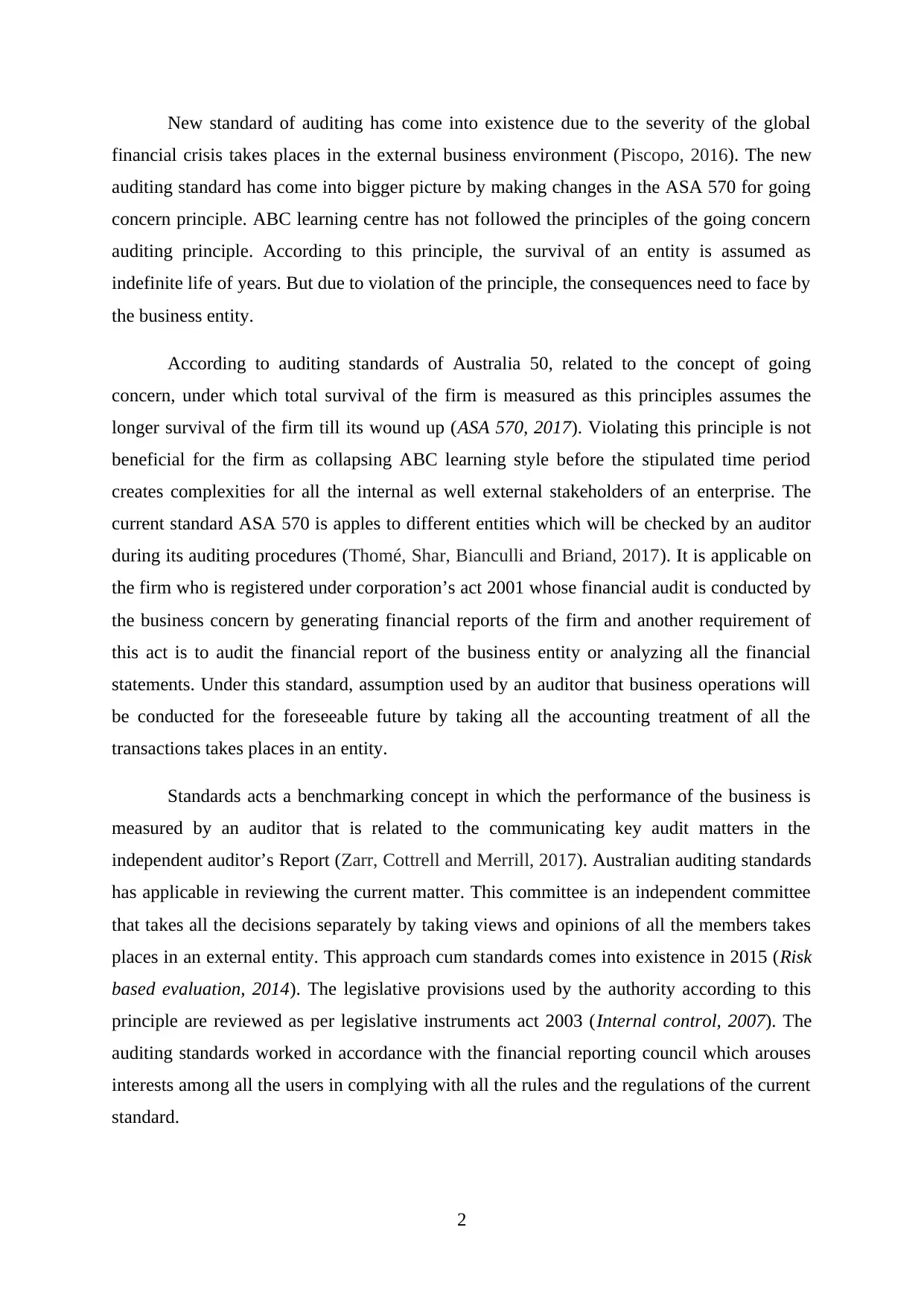
New standard of auditing has come into existence due to the severity of the global
financial crisis takes places in the external business environment (Piscopo, 2016). The new
auditing standard has come into bigger picture by making changes in the ASA 570 for going
concern principle. ABC learning centre has not followed the principles of the going concern
auditing principle. According to this principle, the survival of an entity is assumed as
indefinite life of years. But due to violation of the principle, the consequences need to face by
the business entity.
According to auditing standards of Australia 50, related to the concept of going
concern, under which total survival of the firm is measured as this principles assumes the
longer survival of the firm till its wound up (ASA 570, 2017). Violating this principle is not
beneficial for the firm as collapsing ABC learning style before the stipulated time period
creates complexities for all the internal as well external stakeholders of an enterprise. The
current standard ASA 570 is apples to different entities which will be checked by an auditor
during its auditing procedures (Thomé, Shar, Bianculli and Briand, 2017). It is applicable on
the firm who is registered under corporation’s act 2001 whose financial audit is conducted by
the business concern by generating financial reports of the firm and another requirement of
this act is to audit the financial report of the business entity or analyzing all the financial
statements. Under this standard, assumption used by an auditor that business operations will
be conducted for the foreseeable future by taking all the accounting treatment of all the
transactions takes places in an entity.
Standards acts a benchmarking concept in which the performance of the business is
measured by an auditor that is related to the communicating key audit matters in the
independent auditor’s Report (Zarr, Cottrell and Merrill, 2017). Australian auditing standards
has applicable in reviewing the current matter. This committee is an independent committee
that takes all the decisions separately by taking views and opinions of all the members takes
places in an external entity. This approach cum standards comes into existence in 2015 (Risk
based evaluation, 2014). The legislative provisions used by the authority according to this
principle are reviewed as per legislative instruments act 2003 (Internal control, 2007). The
auditing standards worked in accordance with the financial reporting council which arouses
interests among all the users in complying with all the rules and the regulations of the current
standard.
2
financial crisis takes places in the external business environment (Piscopo, 2016). The new
auditing standard has come into bigger picture by making changes in the ASA 570 for going
concern principle. ABC learning centre has not followed the principles of the going concern
auditing principle. According to this principle, the survival of an entity is assumed as
indefinite life of years. But due to violation of the principle, the consequences need to face by
the business entity.
According to auditing standards of Australia 50, related to the concept of going
concern, under which total survival of the firm is measured as this principles assumes the
longer survival of the firm till its wound up (ASA 570, 2017). Violating this principle is not
beneficial for the firm as collapsing ABC learning style before the stipulated time period
creates complexities for all the internal as well external stakeholders of an enterprise. The
current standard ASA 570 is apples to different entities which will be checked by an auditor
during its auditing procedures (Thomé, Shar, Bianculli and Briand, 2017). It is applicable on
the firm who is registered under corporation’s act 2001 whose financial audit is conducted by
the business concern by generating financial reports of the firm and another requirement of
this act is to audit the financial report of the business entity or analyzing all the financial
statements. Under this standard, assumption used by an auditor that business operations will
be conducted for the foreseeable future by taking all the accounting treatment of all the
transactions takes places in an entity.
Standards acts a benchmarking concept in which the performance of the business is
measured by an auditor that is related to the communicating key audit matters in the
independent auditor’s Report (Zarr, Cottrell and Merrill, 2017). Australian auditing standards
has applicable in reviewing the current matter. This committee is an independent committee
that takes all the decisions separately by taking views and opinions of all the members takes
places in an external entity. This approach cum standards comes into existence in 2015 (Risk
based evaluation, 2014). The legislative provisions used by the authority according to this
principle are reviewed as per legislative instruments act 2003 (Internal control, 2007). The
auditing standards worked in accordance with the financial reporting council which arouses
interests among all the users in complying with all the rules and the regulations of the current
standard.
2
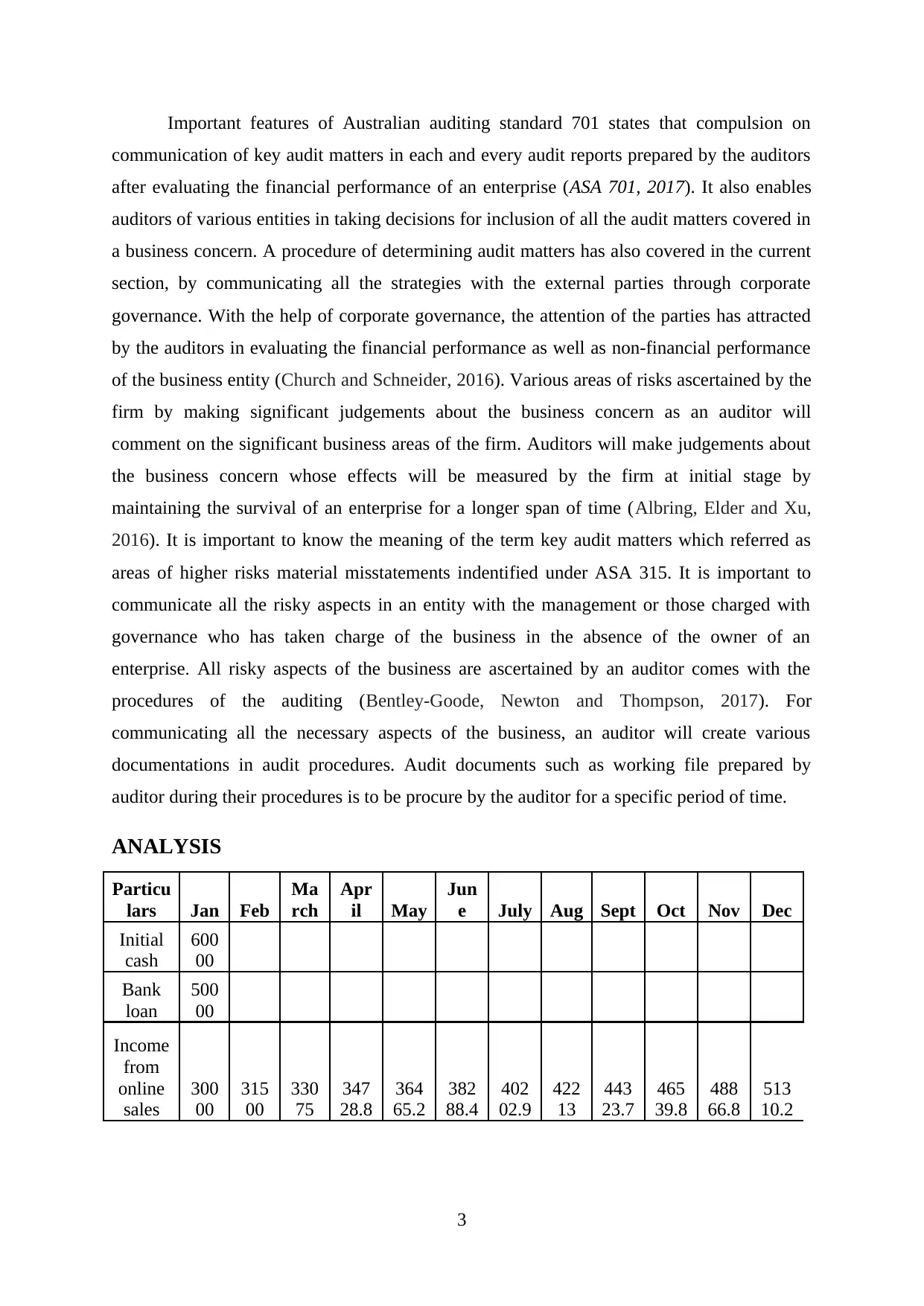
Important features of Australian auditing standard 701 states that compulsion on
communication of key audit matters in each and every audit reports prepared by the auditors
after evaluating the financial performance of an enterprise (ASA 701, 2017). It also enables
auditors of various entities in taking decisions for inclusion of all the audit matters covered in
a business concern. A procedure of determining audit matters has also covered in the current
section, by communicating all the strategies with the external parties through corporate
governance. With the help of corporate governance, the attention of the parties has attracted
by the auditors in evaluating the financial performance as well as non-financial performance
of the business entity (Church and Schneider, 2016). Various areas of risks ascertained by the
firm by making significant judgements about the business concern as an auditor will
comment on the significant business areas of the firm. Auditors will make judgements about
the business concern whose effects will be measured by the firm at initial stage by
maintaining the survival of an enterprise for a longer span of time (Albring, Elder and Xu,
2016). It is important to know the meaning of the term key audit matters which referred as
areas of higher risks material misstatements indentified under ASA 315. It is important to
communicate all the risky aspects in an entity with the management or those charged with
governance who has taken charge of the business in the absence of the owner of an
enterprise. All risky aspects of the business are ascertained by an auditor comes with the
procedures of the auditing (Bentley-Goode, Newton and Thompson, 2017). For
communicating all the necessary aspects of the business, an auditor will create various
documentations in audit procedures. Audit documents such as working file prepared by
auditor during their procedures is to be procure by the auditor for a specific period of time.
ANALYSIS
Particu
lars Jan Feb
Ma
rch
Apr
il May
Jun
e July Aug Sept Oct Nov Dec
Initial
cash
600
00
Bank
loan
500
00
Income
from
online
sales
300
00
315
00
330
75
347
28.8
364
65.2
382
88.4
402
02.9
422
13
443
23.7
465
39.8
488
66.8
513
10.2
3
communication of key audit matters in each and every audit reports prepared by the auditors
after evaluating the financial performance of an enterprise (ASA 701, 2017). It also enables
auditors of various entities in taking decisions for inclusion of all the audit matters covered in
a business concern. A procedure of determining audit matters has also covered in the current
section, by communicating all the strategies with the external parties through corporate
governance. With the help of corporate governance, the attention of the parties has attracted
by the auditors in evaluating the financial performance as well as non-financial performance
of the business entity (Church and Schneider, 2016). Various areas of risks ascertained by the
firm by making significant judgements about the business concern as an auditor will
comment on the significant business areas of the firm. Auditors will make judgements about
the business concern whose effects will be measured by the firm at initial stage by
maintaining the survival of an enterprise for a longer span of time (Albring, Elder and Xu,
2016). It is important to know the meaning of the term key audit matters which referred as
areas of higher risks material misstatements indentified under ASA 315. It is important to
communicate all the risky aspects in an entity with the management or those charged with
governance who has taken charge of the business in the absence of the owner of an
enterprise. All risky aspects of the business are ascertained by an auditor comes with the
procedures of the auditing (Bentley-Goode, Newton and Thompson, 2017). For
communicating all the necessary aspects of the business, an auditor will create various
documentations in audit procedures. Audit documents such as working file prepared by
auditor during their procedures is to be procure by the auditor for a specific period of time.
ANALYSIS
Particu
lars Jan Feb
Ma
rch
Apr
il May
Jun
e July Aug Sept Oct Nov Dec
Initial
cash
600
00
Bank
loan
500
00
Income
from
online
sales
300
00
315
00
330
75
347
28.8
364
65.2
382
88.4
402
02.9
422
13
443
23.7
465
39.8
488
66.8
513
10.2
3
⊘ This is a preview!⊘
Do you want full access?
Subscribe today to unlock all pages.

Trusted by 1+ million students worldwide
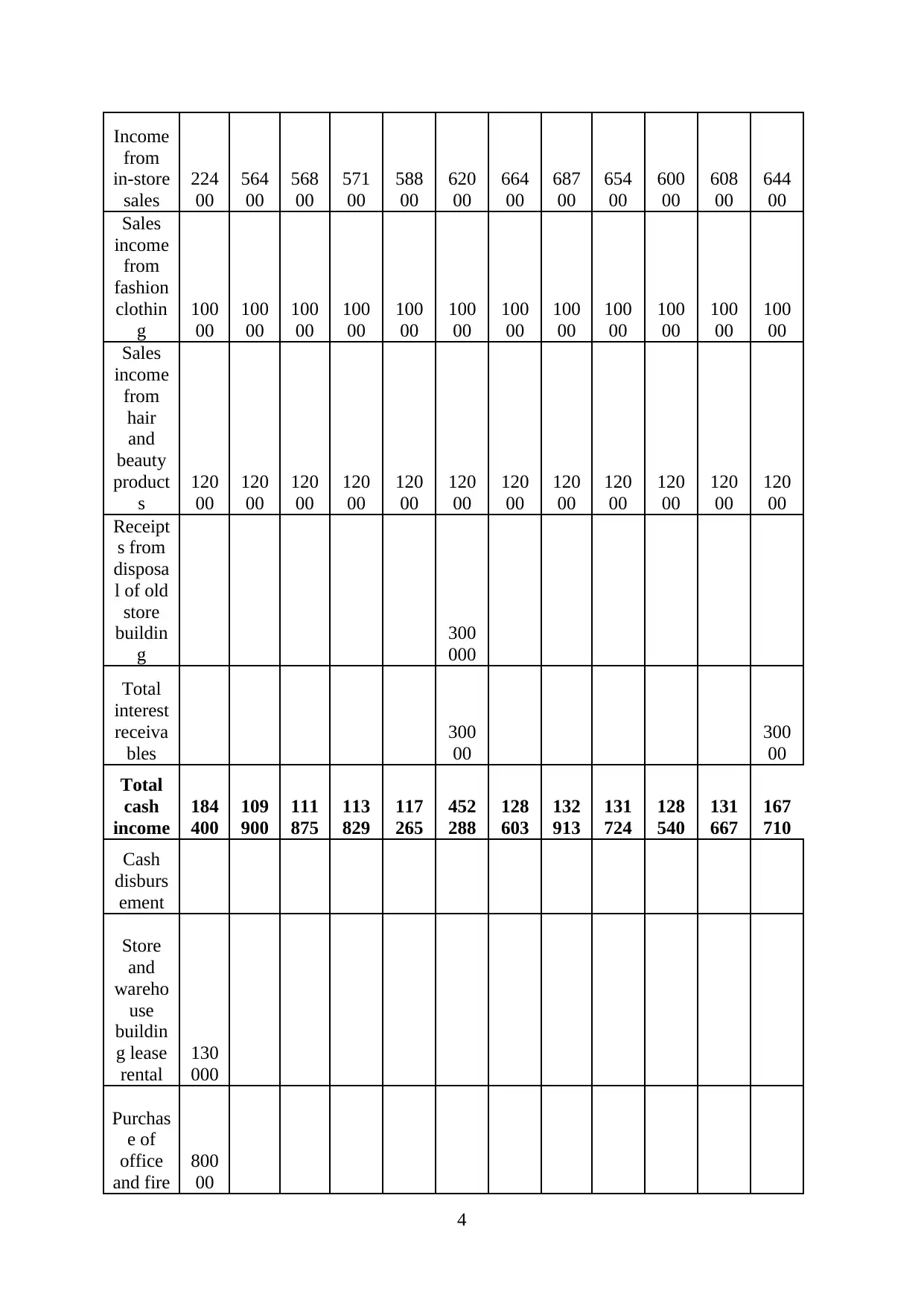
Income
from
in-store
sales
224
00
564
00
568
00
571
00
588
00
620
00
664
00
687
00
654
00
600
00
608
00
644
00
Sales
income
from
fashion
clothin
g
100
00
100
00
100
00
100
00
100
00
100
00
100
00
100
00
100
00
100
00
100
00
100
00
Sales
income
from
hair
and
beauty
product
s
120
00
120
00
120
00
120
00
120
00
120
00
120
00
120
00
120
00
120
00
120
00
120
00
Receipt
s from
disposa
l of old
store
buildin
g
300
000
Total
interest
receiva
bles
300
00
300
00
Total
cash
income
184
400
109
900
111
875
113
829
117
265
452
288
128
603
132
913
131
724
128
540
131
667
167
710
Cash
disburs
ement
Store
and
wareho
use
buildin
g lease
rental
130
000
Purchas
e of
office
and fire
800
00
4
from
in-store
sales
224
00
564
00
568
00
571
00
588
00
620
00
664
00
687
00
654
00
600
00
608
00
644
00
Sales
income
from
fashion
clothin
g
100
00
100
00
100
00
100
00
100
00
100
00
100
00
100
00
100
00
100
00
100
00
100
00
Sales
income
from
hair
and
beauty
product
s
120
00
120
00
120
00
120
00
120
00
120
00
120
00
120
00
120
00
120
00
120
00
120
00
Receipt
s from
disposa
l of old
store
buildin
g
300
000
Total
interest
receiva
bles
300
00
300
00
Total
cash
income
184
400
109
900
111
875
113
829
117
265
452
288
128
603
132
913
131
724
128
540
131
667
167
710
Cash
disburs
ement
Store
and
wareho
use
buildin
g lease
rental
130
000
Purchas
e of
office
and fire
800
00
4
Paraphrase This Document
Need a fresh take? Get an instant paraphrase of this document with our AI Paraphraser
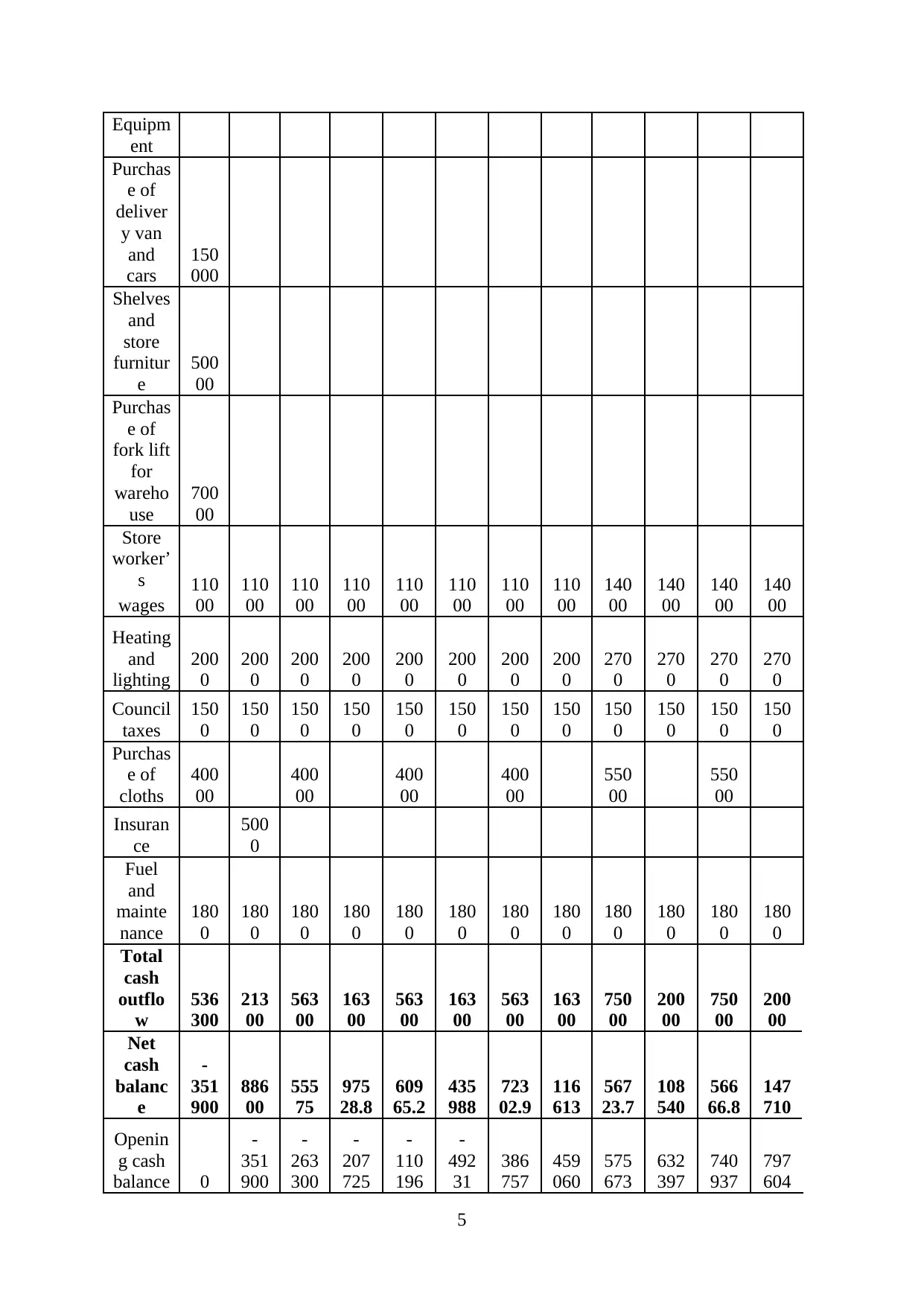
Equipm
ent
Purchas
e of
deliver
y van
and
cars
150
000
Shelves
and
store
furnitur
e
500
00
Purchas
e of
fork lift
for
wareho
use
700
00
Store
worker’
s 110
00
110
00
110
00
110
00
110
00
110
00
110
00
110
00
140
00
140
00
140
00
140
00wages
Heating
and
lighting
200
0
200
0
200
0
200
0
200
0
200
0
200
0
200
0
270
0
270
0
270
0
270
0
Council
taxes
150
0
150
0
150
0
150
0
150
0
150
0
150
0
150
0
150
0
150
0
150
0
150
0
Purchas
e of
cloths
400
00
400
00
400
00
400
00
550
00
550
00
Insuran
ce
500
0
Fuel
and
mainte
nance
180
0
180
0
180
0
180
0
180
0
180
0
180
0
180
0
180
0
180
0
180
0
180
0
Total
cash
outflo
w
536
300
213
00
563
00
163
00
563
00
163
00
563
00
163
00
750
00
200
00
750
00
200
00
Net
cash
balanc
e
-
351
900
886
00
555
75
975
28.8
609
65.2
435
988
723
02.9
116
613
567
23.7
108
540
566
66.8
147
710
Openin
g cash
balance 0
-
351
900
-
263
300
-
207
725
-
110
196
-
492
31
386
757
459
060
575
673
632
397
740
937
797
604
5
ent
Purchas
e of
deliver
y van
and
cars
150
000
Shelves
and
store
furnitur
e
500
00
Purchas
e of
fork lift
for
wareho
use
700
00
Store
worker’
s 110
00
110
00
110
00
110
00
110
00
110
00
110
00
110
00
140
00
140
00
140
00
140
00wages
Heating
and
lighting
200
0
200
0
200
0
200
0
200
0
200
0
200
0
200
0
270
0
270
0
270
0
270
0
Council
taxes
150
0
150
0
150
0
150
0
150
0
150
0
150
0
150
0
150
0
150
0
150
0
150
0
Purchas
e of
cloths
400
00
400
00
400
00
400
00
550
00
550
00
Insuran
ce
500
0
Fuel
and
mainte
nance
180
0
180
0
180
0
180
0
180
0
180
0
180
0
180
0
180
0
180
0
180
0
180
0
Total
cash
outflo
w
536
300
213
00
563
00
163
00
563
00
163
00
563
00
163
00
750
00
200
00
750
00
200
00
Net
cash
balanc
e
-
351
900
886
00
555
75
975
28.8
609
65.2
435
988
723
02.9
116
613
567
23.7
108
540
566
66.8
147
710
Openin
g cash
balance 0
-
351
900
-
263
300
-
207
725
-
110
196
-
492
31
386
757
459
060
575
673
632
397
740
937
797
604
5
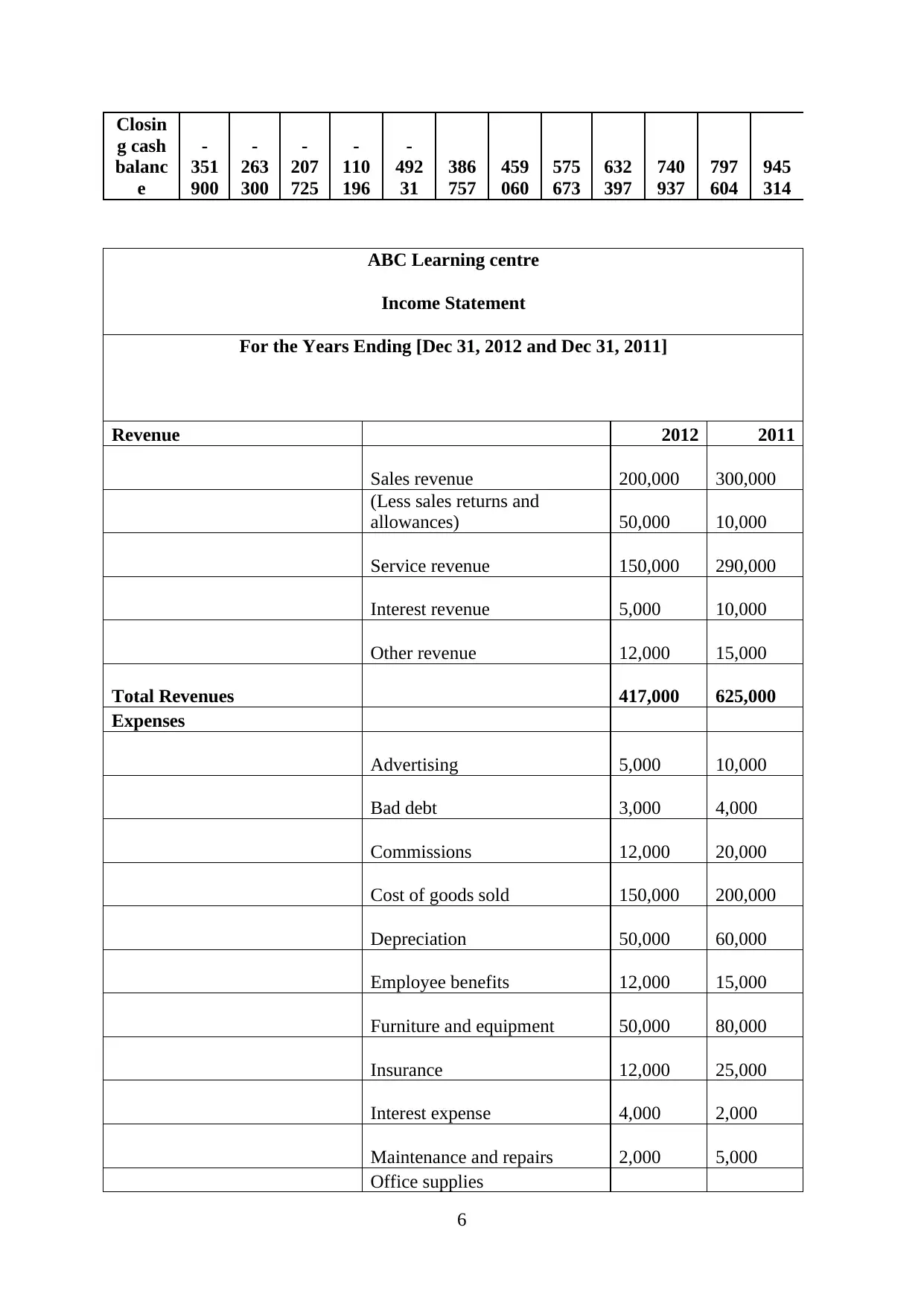
Closin
g cash
balanc
e
-
351
900
-
263
300
-
207
725
-
110
196
-
492
31
386
757
459
060
575
673
632
397
740
937
797
604
945
314
ABC Learning centre
Income Statement
For the Years Ending [Dec 31, 2012 and Dec 31, 2011]
Revenue 2012 2011
Sales revenue 200,000 300,000
(Less sales returns and
allowances) 50,000 10,000
Service revenue 150,000 290,000
Interest revenue 5,000 10,000
Other revenue 12,000 15,000
Total Revenues 417,000 625,000
Expenses
Advertising 5,000 10,000
Bad debt 3,000 4,000
Commissions 12,000 20,000
Cost of goods sold 150,000 200,000
Depreciation 50,000 60,000
Employee benefits 12,000 15,000
Furniture and equipment 50,000 80,000
Insurance 12,000 25,000
Interest expense 4,000 2,000
Maintenance and repairs 2,000 5,000
Office supplies
6
g cash
balanc
e
-
351
900
-
263
300
-
207
725
-
110
196
-
492
31
386
757
459
060
575
673
632
397
740
937
797
604
945
314
ABC Learning centre
Income Statement
For the Years Ending [Dec 31, 2012 and Dec 31, 2011]
Revenue 2012 2011
Sales revenue 200,000 300,000
(Less sales returns and
allowances) 50,000 10,000
Service revenue 150,000 290,000
Interest revenue 5,000 10,000
Other revenue 12,000 15,000
Total Revenues 417,000 625,000
Expenses
Advertising 5,000 10,000
Bad debt 3,000 4,000
Commissions 12,000 20,000
Cost of goods sold 150,000 200,000
Depreciation 50,000 60,000
Employee benefits 12,000 15,000
Furniture and equipment 50,000 80,000
Insurance 12,000 25,000
Interest expense 4,000 2,000
Maintenance and repairs 2,000 5,000
Office supplies
6
⊘ This is a preview!⊘
Do you want full access?
Subscribe today to unlock all pages.

Trusted by 1+ million students worldwide
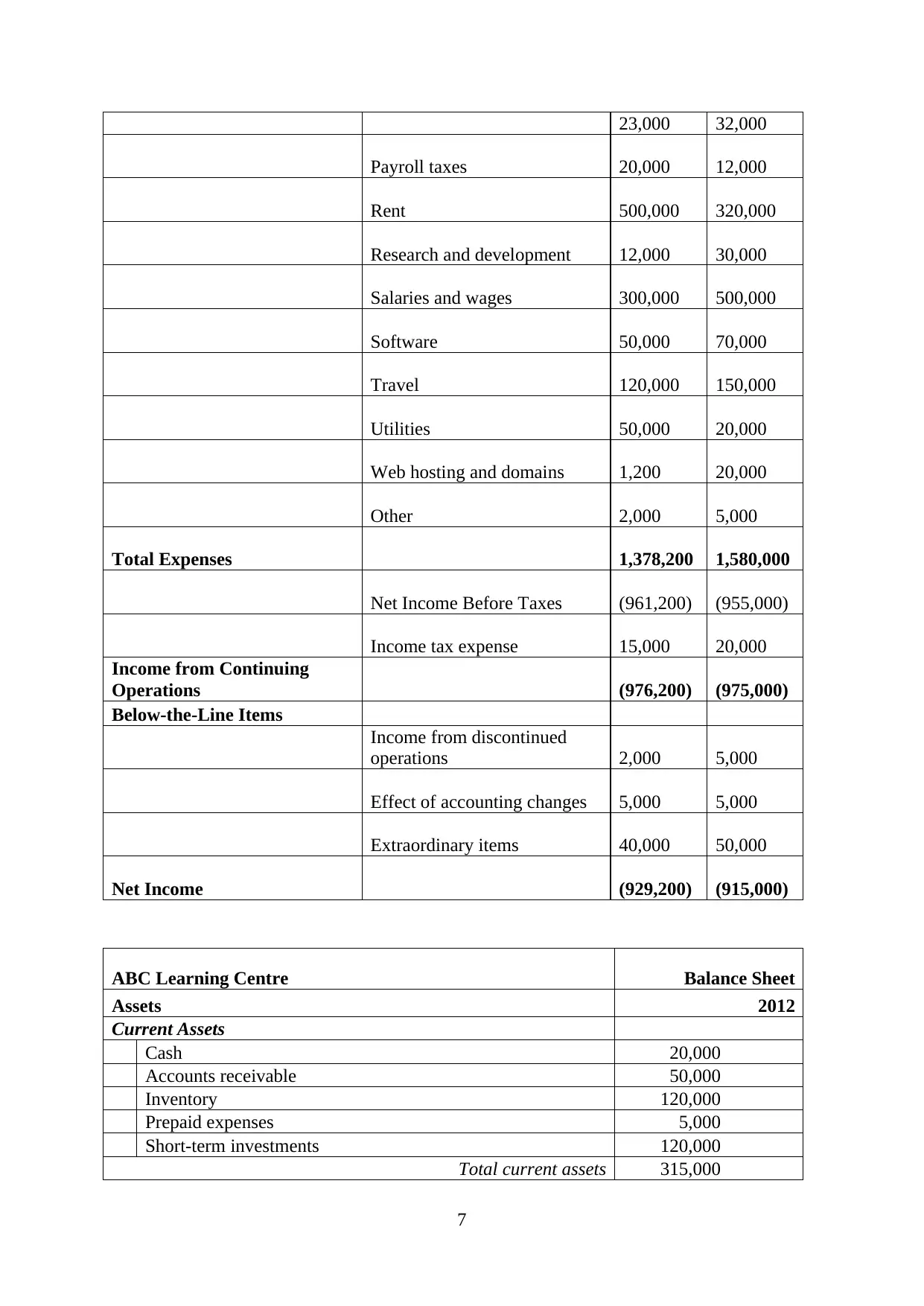
23,000 32,000
Payroll taxes 20,000 12,000
Rent 500,000 320,000
Research and development 12,000 30,000
Salaries and wages 300,000 500,000
Software 50,000 70,000
Travel 120,000 150,000
Utilities 50,000 20,000
Web hosting and domains 1,200 20,000
Other 2,000 5,000
Total Expenses 1,378,200 1,580,000
Net Income Before Taxes (961,200) (955,000)
Income tax expense 15,000 20,000
Income from Continuing
Operations (976,200) (975,000)
Below-the-Line Items
Income from discontinued
operations 2,000 5,000
Effect of accounting changes 5,000 5,000
Extraordinary items 40,000 50,000
Net Income (929,200) (915,000)
ABC Learning Centre Balance Sheet
Assets 2012
Current Assets
Cash 20,000
Accounts receivable 50,000
Inventory 120,000
Prepaid expenses 5,000
Short-term investments 120,000
Total current assets 315,000
7
Payroll taxes 20,000 12,000
Rent 500,000 320,000
Research and development 12,000 30,000
Salaries and wages 300,000 500,000
Software 50,000 70,000
Travel 120,000 150,000
Utilities 50,000 20,000
Web hosting and domains 1,200 20,000
Other 2,000 5,000
Total Expenses 1,378,200 1,580,000
Net Income Before Taxes (961,200) (955,000)
Income tax expense 15,000 20,000
Income from Continuing
Operations (976,200) (975,000)
Below-the-Line Items
Income from discontinued
operations 2,000 5,000
Effect of accounting changes 5,000 5,000
Extraordinary items 40,000 50,000
Net Income (929,200) (915,000)
ABC Learning Centre Balance Sheet
Assets 2012
Current Assets
Cash 20,000
Accounts receivable 50,000
Inventory 120,000
Prepaid expenses 5,000
Short-term investments 120,000
Total current assets 315,000
7
Paraphrase This Document
Need a fresh take? Get an instant paraphrase of this document with our AI Paraphraser
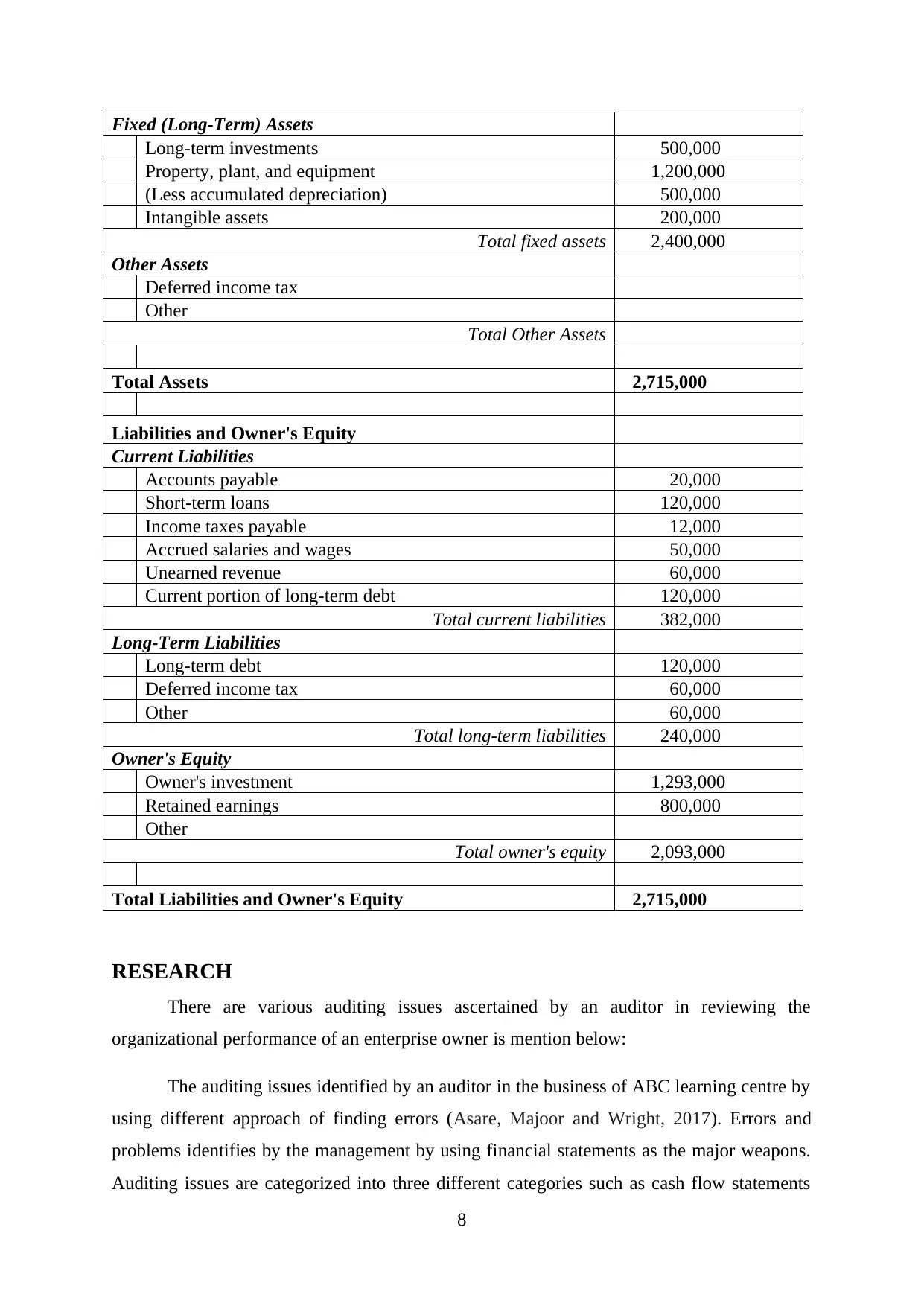
Fixed (Long-Term) Assets
Long-term investments 500,000
Property, plant, and equipment 1,200,000
(Less accumulated depreciation) 500,000
Intangible assets 200,000
Total fixed assets 2,400,000
Other Assets
Deferred income tax
Other
Total Other Assets
Total Assets 2,715,000
Liabilities and Owner's Equity
Current Liabilities
Accounts payable 20,000
Short-term loans 120,000
Income taxes payable 12,000
Accrued salaries and wages 50,000
Unearned revenue 60,000
Current portion of long-term debt 120,000
Total current liabilities 382,000
Long-Term Liabilities
Long-term debt 120,000
Deferred income tax 60,000
Other 60,000
Total long-term liabilities 240,000
Owner's Equity
Owner's investment 1,293,000
Retained earnings 800,000
Other
Total owner's equity 2,093,000
Total Liabilities and Owner's Equity 2,715,000
RESEARCH
There are various auditing issues ascertained by an auditor in reviewing the
organizational performance of an enterprise owner is mention below:
The auditing issues identified by an auditor in the business of ABC learning centre by
using different approach of finding errors (Asare, Majoor and Wright, 2017). Errors and
problems identifies by the management by using financial statements as the major weapons.
Auditing issues are categorized into three different categories such as cash flow statements
8
Long-term investments 500,000
Property, plant, and equipment 1,200,000
(Less accumulated depreciation) 500,000
Intangible assets 200,000
Total fixed assets 2,400,000
Other Assets
Deferred income tax
Other
Total Other Assets
Total Assets 2,715,000
Liabilities and Owner's Equity
Current Liabilities
Accounts payable 20,000
Short-term loans 120,000
Income taxes payable 12,000
Accrued salaries and wages 50,000
Unearned revenue 60,000
Current portion of long-term debt 120,000
Total current liabilities 382,000
Long-Term Liabilities
Long-term debt 120,000
Deferred income tax 60,000
Other 60,000
Total long-term liabilities 240,000
Owner's Equity
Owner's investment 1,293,000
Retained earnings 800,000
Other
Total owner's equity 2,093,000
Total Liabilities and Owner's Equity 2,715,000
RESEARCH
There are various auditing issues ascertained by an auditor in reviewing the
organizational performance of an enterprise owner is mention below:
The auditing issues identified by an auditor in the business of ABC learning centre by
using different approach of finding errors (Asare, Majoor and Wright, 2017). Errors and
problems identifies by the management by using financial statements as the major weapons.
Auditing issues are categorized into three different categories such as cash flow statements
8
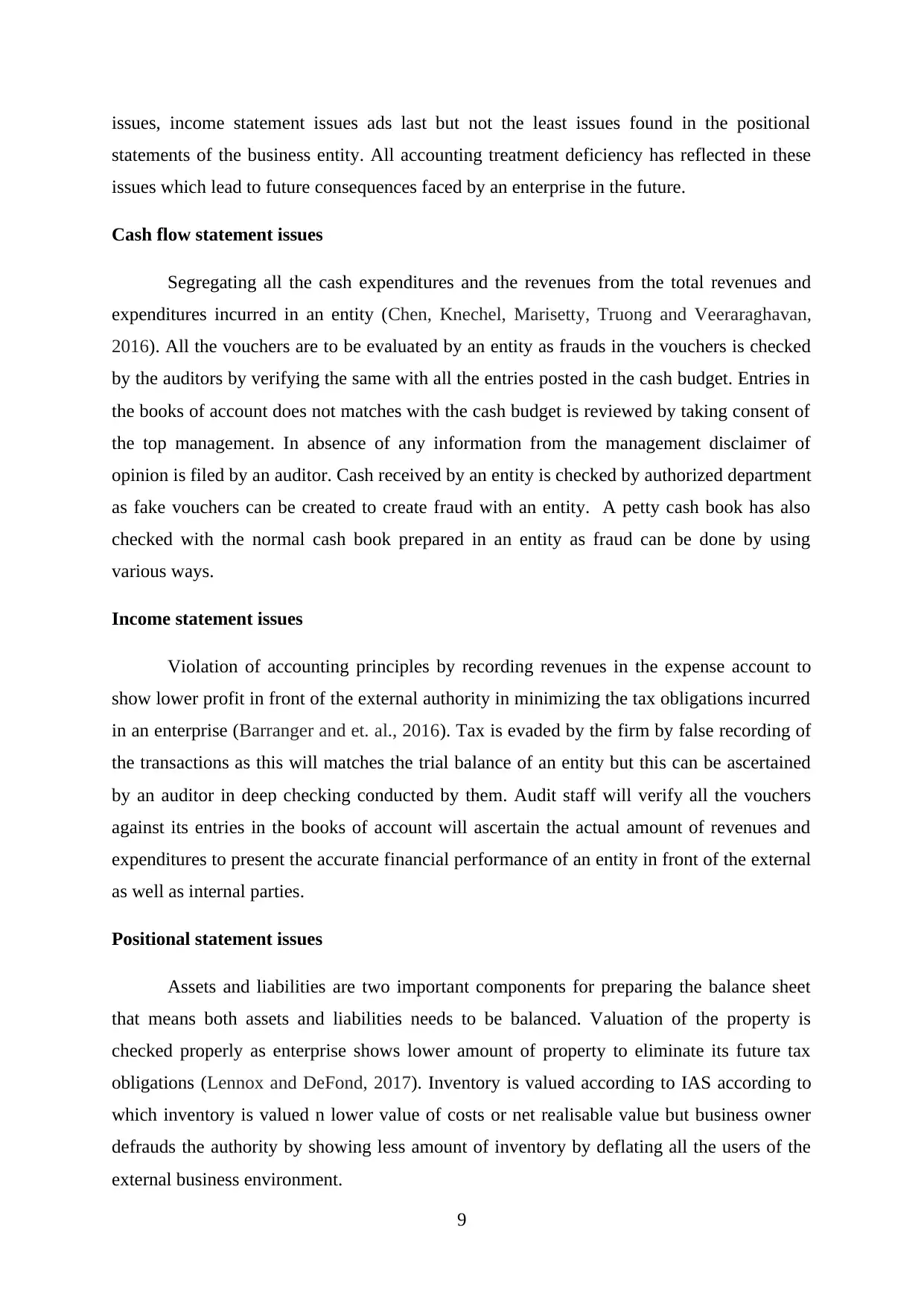
issues, income statement issues ads last but not the least issues found in the positional
statements of the business entity. All accounting treatment deficiency has reflected in these
issues which lead to future consequences faced by an enterprise in the future.
Cash flow statement issues
Segregating all the cash expenditures and the revenues from the total revenues and
expenditures incurred in an entity (Chen, Knechel, Marisetty, Truong and Veeraraghavan,
2016). All the vouchers are to be evaluated by an entity as frauds in the vouchers is checked
by the auditors by verifying the same with all the entries posted in the cash budget. Entries in
the books of account does not matches with the cash budget is reviewed by taking consent of
the top management. In absence of any information from the management disclaimer of
opinion is filed by an auditor. Cash received by an entity is checked by authorized department
as fake vouchers can be created to create fraud with an entity. A petty cash book has also
checked with the normal cash book prepared in an entity as fraud can be done by using
various ways.
Income statement issues
Violation of accounting principles by recording revenues in the expense account to
show lower profit in front of the external authority in minimizing the tax obligations incurred
in an enterprise (Barranger and et. al., 2016). Tax is evaded by the firm by false recording of
the transactions as this will matches the trial balance of an entity but this can be ascertained
by an auditor in deep checking conducted by them. Audit staff will verify all the vouchers
against its entries in the books of account will ascertain the actual amount of revenues and
expenditures to present the accurate financial performance of an entity in front of the external
as well as internal parties.
Positional statement issues
Assets and liabilities are two important components for preparing the balance sheet
that means both assets and liabilities needs to be balanced. Valuation of the property is
checked properly as enterprise shows lower amount of property to eliminate its future tax
obligations (Lennox and DeFond, 2017). Inventory is valued according to IAS according to
which inventory is valued n lower value of costs or net realisable value but business owner
defrauds the authority by showing less amount of inventory by deflating all the users of the
external business environment.
9
statements of the business entity. All accounting treatment deficiency has reflected in these
issues which lead to future consequences faced by an enterprise in the future.
Cash flow statement issues
Segregating all the cash expenditures and the revenues from the total revenues and
expenditures incurred in an entity (Chen, Knechel, Marisetty, Truong and Veeraraghavan,
2016). All the vouchers are to be evaluated by an entity as frauds in the vouchers is checked
by the auditors by verifying the same with all the entries posted in the cash budget. Entries in
the books of account does not matches with the cash budget is reviewed by taking consent of
the top management. In absence of any information from the management disclaimer of
opinion is filed by an auditor. Cash received by an entity is checked by authorized department
as fake vouchers can be created to create fraud with an entity. A petty cash book has also
checked with the normal cash book prepared in an entity as fraud can be done by using
various ways.
Income statement issues
Violation of accounting principles by recording revenues in the expense account to
show lower profit in front of the external authority in minimizing the tax obligations incurred
in an enterprise (Barranger and et. al., 2016). Tax is evaded by the firm by false recording of
the transactions as this will matches the trial balance of an entity but this can be ascertained
by an auditor in deep checking conducted by them. Audit staff will verify all the vouchers
against its entries in the books of account will ascertain the actual amount of revenues and
expenditures to present the accurate financial performance of an entity in front of the external
as well as internal parties.
Positional statement issues
Assets and liabilities are two important components for preparing the balance sheet
that means both assets and liabilities needs to be balanced. Valuation of the property is
checked properly as enterprise shows lower amount of property to eliminate its future tax
obligations (Lennox and DeFond, 2017). Inventory is valued according to IAS according to
which inventory is valued n lower value of costs or net realisable value but business owner
defrauds the authority by showing less amount of inventory by deflating all the users of the
external business environment.
9
⊘ This is a preview!⊘
Do you want full access?
Subscribe today to unlock all pages.

Trusted by 1+ million students worldwide
1 out of 16
Related Documents
Your All-in-One AI-Powered Toolkit for Academic Success.
+13062052269
info@desklib.com
Available 24*7 on WhatsApp / Email
![[object Object]](/_next/static/media/star-bottom.7253800d.svg)
Unlock your academic potential
Copyright © 2020–2025 A2Z Services. All Rights Reserved. Developed and managed by ZUCOL.





